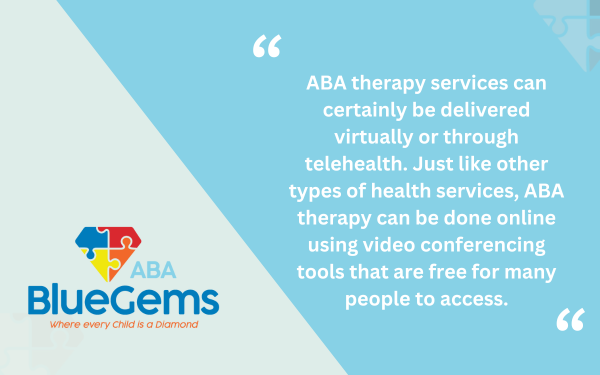Can ABA Therapy Be Done Virtually or Through Telehealth?
Virtual and telehealth services exploded as a necessary and viable alternative to in-person healthcare visits out of necessity during the COVID-19 pandemic. Luckily, technology had advanced enough in the years leading up to the pandemic that many people were still able to connect with a health-care provider they needed for non-emergency medical attention when they were forced to stay at home or it was advisable for them to avoid a crowded doctor’s office.
Even when the pandemic waned and then finally ended, telehealth services stuck around because for many reasons, not the least of which is they are efficient and convenient.
Virtual and telehealth are great for some services, but not for all. Despite the ability to conduct visits virtually, there are some health-care appointments that are best done in-person.
For children with autism spectrum disorder (ASD) who get applied behavior analysis (ABA therapy) treatment, there may come a time when attending an in-person session may not be feasible. In those cases, can ABA therapy be done virtually or through telehealth?
We’ll seek to best answer that question below.
Table Of Contents
Is It Possible to Get ABA Therapy Virtually?
ABA therapy services can certainly be delivered virtually or through telehealth. Just like other types of health services, ABA therapy can be done online using video conferencing tools that are free for many people to access.

The treatment can be administered in the same way that it is in-person, though it’s likely to require the hands-on help and support of an adult supervisor who’s in the same room as the child with autism.
Telehealth services for ABA therapy can be done for many different aspects of the treatment.
There can be direct therapy between the therapist and the patient. It can be used for parent coaching, in which the parents, caregivers and others can speak directly with the therapy team to gain insights into how they can best support children with ASD.
Virtual services can also be used as a way for Board Certified Behavior Analysts (BCBAs) to oversee Registered Behavior Technicians (RBTs) who are often the ones delivering the therapy services directly to patients.
Whether virtual ABA therapy is a good idea or not depends on a number of factors that are specific to the patient, family and types of services being delivered.
| Feature | In-Person ABA Therapy | Virtual ABA Therapy |
|---|---|---|
| Therapist Presence | Physically present | Via video conferencing |
| Parental Role | Supportive, not required at every session | Actively involved, often as aide |
| Child Engagement | Easier to maintain | May be harder to sustain |
| Accessibility | Depends on location | Accessible from anywhere |
| Technology Needs | Minimal | High – device and stable internet |
What Are the Benefits of Virtual ABA Therapy?
If the situation is right, virtual ABA therapy sessions can provide a number of benefits to patients and their families.
First, it increases accessibility to the services. Some families who live in a rural area or aren’t close to an ABA therapy provider can get the needed services for their children without having to search high and low to find availability.
Virtual services are also extremely convenient, regardless of where you live. Being able to get ABA therapy via telehealth enables parents to schedule the sessions when it’s most convenient for them, without having to waste time transporting their child to and from a clinic.
In the same vein, it allows parents to be more directly involved in their child’s therapy, which is essential to the overall success of it. Plus, being able to stay at home to receive services can make the child feel more comfortable and less anxious.
| Scenario | Suitability for Virtual ABA Therapy | Notes |
|---|---|---|
| Rural Location | High | Solves provider access issue |
| Tech-Savvy Family | High | Can navigate platforms easily |
| Child Needs Hands-On Help | Low | Better suited for in-person |
| Parent Available During Sessions | High | Supports therapy implementation |
| Easily Distracted Child | Low | May struggle to engage virtually |
What Are the Downsides of Virtual ABA Therapy?
Despite the above benefits, there are some downsides of virtual ABA therapy.
First, the family must have access to the technology that powers telehealth services, including a computer, tablet or phone and stable and strong internet connection.
Parents or caregivers also will likely need to be present to help set up the connection and keep their child on task. They will essentially be serving as the aide to the therapist, since the therapist won’t be “on site” with the patient.
It may be challenging to keep the child’s attention during telehealth services and/or keep them engaged and motivated in the tasks at hand. Attention is crucial to success in ABA therapy, and it may be difficult to establish or maintain it over a computer screen.
Finally, when the therapist can’t be in the same room with the child, it may be hard to provide them with the support that they need. Some children will simply need more hands-on help than others, especially for certain tasks, which makes ABA therapy telehealth services not a great fit for all.
Blue Gems ABA Harnessing the Power of Technology to Deliver ABA Therapy
ABA therapy can certainly be done virtually or through telehealth, though it’s not a great fit for everyone and every situation. There are times when families and patients can gain immense benefits from virtual services, and other times when it’s simply not the best solution.
At Blue Gems ABA, we harness the power of modern technology to deliver ABA therapy services to children with ASD in the best way possible. We offer telehealth services when needed, as well as clinic-based and home-based services.
To learn more, please contact us today.




